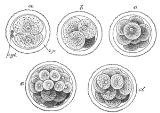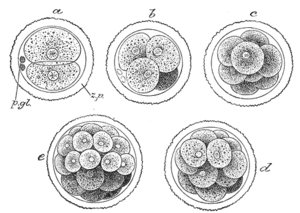
Polar body
Encyclopedia

Cell (biology)
The cell is the basic structural and functional unit of all known living organisms. It is the smallest unit of life that is classified as a living thing, and is often called the building block of life. The Alberts text discusses how the "cellular building blocks" move to shape developing embryos....
structure found inside an ovum
Ovum
An ovum is a haploid female reproductive cell or gamete. Both animals and embryophytes have ova. The term ovule is used for the young ovum of an animal, as well as the plant structure that carries the female gametophyte and egg cell and develops into a seed after fertilization...
. Both animal
Animal
Animals are a major group of multicellular, eukaryotic organisms of the kingdom Animalia or Metazoa. Their body plan eventually becomes fixed as they develop, although some undergo a process of metamorphosis later on in their life. Most animals are motile, meaning they can move spontaneously and...
and plant
Plant
Plants are living organisms belonging to the kingdom Plantae. Precise definitions of the kingdom vary, but as the term is used here, plants include familiar organisms such as trees, flowers, herbs, bushes, grasses, vines, ferns, mosses, and green algae. The group is also called green plants or...
ova possess it. It is also known as a polar cell.
Asymmetrical cell division (cytokinesis
Cytokinesis
Cytokinesis is the process in which the cytoplasm of a single eukaryotic cell is divided to form two daughter cells. It usually initiates during the late stages of mitosis, and sometimes meiosis, splitting a binucleate cell in two, to ensure that chromosome number is maintained from one generation...
) leads to the production of polar bodies during oogenesis
Oogenesis
Oogenesis, ovogenesis or oögenesis is the creation of an ovum . It is the female form of gametogenesis. The male equivalent is spermatogenesis...
. To conserve nutrients, the majority of cytoplasm
Cytoplasm
The cytoplasm is a small gel-like substance residing between the cell membrane holding all the cell's internal sub-structures , except for the nucleus. All the contents of the cells of prokaryote organisms are contained within the cytoplasm...
is segregated into the secondary oocyte
Oocyte
An oocyte, ovocyte, or rarely ocyte, is a female gametocyte or germ cell involved in reproduction. In other words, it is an immature ovum, or egg cell. An oocyte is produced in the ovary during female gametogenesis. The female germ cells produce a primordial germ cell which undergoes a mitotic...
during meiosis
Meiosis
Meiosis is a special type of cell division necessary for sexual reproduction. The cells produced by meiosis are gametes or spores. The animals' gametes are called sperm and egg cells....
I, and the ovum during meiosis II. The remaining daughter cells generated from the meiotic events are small and contain relatively little cytoplasm and are referred to as polar bodies. Eventually, the polar bodies degenerate.
There may be one or two polar bodies in the ovum.
The first polar body is one of the two products in the first stage of meiosis and is considered haploid, with 23 chromosomes and 46 chromatids. The second polar body is also haploid, with 23 chromosomes and 23 chromatids. Sometimes the first polar body undergoes the second meiotic cell division.
In flowering plant
Flowering plant
The flowering plants , also known as Angiospermae or Magnoliophyta, are the most diverse group of land plants. Angiosperms are seed-producing plants like the gymnosperms and can be distinguished from the gymnosperms by a series of synapomorphies...
s, the pollen
Pollen
Pollen is a fine to coarse powder containing the microgametophytes of seed plants, which produce the male gametes . Pollen grains have a hard coat that protects the sperm cells during the process of their movement from the stamens to the pistil of flowering plants or from the male cone to the...
releases two male gametes (sperm
Sperm
The term sperm is derived from the Greek word sperma and refers to the male reproductive cells. In the types of sexual reproduction known as anisogamy and oogamy, there is a marked difference in the size of the gametes with the smaller one being termed the "male" or sperm cell...
nuclei) into the ovule
Ovule
Ovule means "small egg". In seed plants, the ovule is the structure that gives rise to and contains the female reproductive cells. It consists of three parts: The integument forming its outer layer, the nucellus , and the megaspore-derived female gametophyte in its center...
upon fertilization. One fertilizes the haploid ovum and develops into a normal embryo, while the other fertilizes the two polar bodies within the center of the ovary, creating a structure called endosperm
Endosperm
Endosperm is the tissue produced inside the seeds of most flowering plants around the time of fertilization. It surrounds the embryo and provides nutrition in the form of starch, though it can also contain oils and protein. This makes endosperm an important source of nutrition in human diet...
. Endosperm stores nutrients for initial growth of plant seed
Seed
A seed is a small embryonic plant enclosed in a covering called the seed coat, usually with some stored food. It is the product of the ripened ovule of gymnosperm and angiosperm plants which occurs after fertilization and some growth within the mother plant...
s. Cereal grain
Cereal
Cereals are grasses cultivated for the edible components of their grain , composed of the endosperm, germ, and bran...
is an example of this, and is consumed for its nutritional value by many animals, including humans.
Polar bodies are the by-products of the egg’s division during meiosis
Meiosis
Meiosis is a special type of cell division necessary for sexual reproduction. The cells produced by meiosis are gametes or spores. The animals' gametes are called sperm and egg cells....
. As an egg matures, it goes through a two-step division process, dividing once at the time when ovulation would occur and again at the time of fertilization. The three haploid polar bodies are the by-products of this division, and are essentially discarded by the egg. By analyzing the polar bodies, it is possible to infer the genetic status of the egg. Therefore, polar body analysis allows us to test the mother’s genetic contribution to the embryo.
Polar body twinning
Polar body twinning is a hypothesized form of twinningTwin
A twin is one of two offspring produced in the same pregnancy. Twins can either be monozygotic , meaning that they develop from one zygote that splits and forms two embryos, or dizygotic because they develop from two separate eggs that are fertilized by two separate sperm.In contrast, a fetus...
in the female, where a polar body does not disintegrate and is fertilized by a sperm
Spermatozoon
A spermatozoon is a motile sperm cell, or moving form of the haploid cell that is the male gamete. A spermatozoon joins an ovum to form a zygote...
.
However, such development would usually be impossible because it does not have enough cytoplasm (or yolk, if the ovum has yolk) to feed the developing embryo.
Twinning would theoretically occur if two sperm fertilize both the egg and a polar body. Additional fertilization of the first polar body would result in only 25% genetic identity, since the twins would share none of the maternal genome. On the other hand, additional fertilization of the second polar body would result in half twinning with 75% genetic identity, because the twins would share all the maternal genome.

